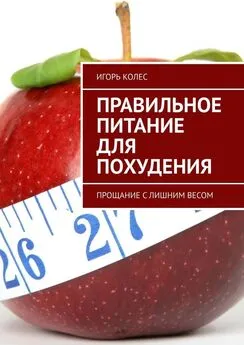Шарлотта Марки - Умным диеты не нужны. Последние научные открытия в области борьбы с лишним весом
- Название:Умным диеты не нужны. Последние научные открытия в области борьбы с лишним весом
- Автор:
- Жанр:
- Издательство:Array Литагент «Альпина»
- Год:2015
- Город:Москва
- ISBN:978-5-9614-3928-1
- Рейтинг:
- Избранное:Добавить в избранное
-
Отзывы:
-
Ваша оценка:
Шарлотта Марки - Умным диеты не нужны. Последние научные открытия в области борьбы с лишним весом краткое содержание
Умным диеты не нужны. Последние научные открытия в области борьбы с лишним весом - читать онлайн бесплатно ознакомительный отрывок
Интервал:
Закладка:
Mathias, K. C., Rolis, B. J., Birch, L. L., Kral, T. V., Hanna, E. L., Davey, A., & Fisher, J. O. (2012). Serving larger portions of fruits and vegetables to gether at dinner promotes intake of both foods among young children. Journal of the Academyof Nutrition and Dietetics , 112, 266–270.
148
Wansick, B. (2006). Mindless eating – why we eat more than we think (massmarket ed.). New York: Bantam Books.
149
Ibid.
150
Disantis, K. I., Birch, L. L., Davey, A., Serrana, E. L., Zhang, J., Bruton, Y., & Fischer, J. O. (2013). Plate size and children’s appetite: Effects of larger dishware on self-served portions and intake. Pediatrics, 131, 1–8. doi:10.1542/peds.2012-2330
151
Polivy, J., & Herman, C. P. (2002). If at first you don’t succeed: False hopes of self-change. American Psychologist , 57, 677–689.
152
Norcross, J. C., Ratzin, A. C., & Payne, D. (1989). Ringing in the New Year: The change processes and reported outcomes of resolutions. Addictive Behaviors, 14, 205–212.
153
Markey, P. M., & Markey, C. N. (2013). Annual variation in internet keyword searches: Linking dieting interest to obesity and negative health outcomes. Journalof Health Psychology , 18, 875–886.
154
Jeffrey, R. W., Epstein, L. H., Wilson, T. G., Drewnowski, A., Stunkard, A. J., & Wing, R. A. (2000). Long-term maintenance of weight loss: Current status. Health Psychology, 19, 5–16. doi: 10.1037/0278-6133.19.Suppl1.5
155
Anderson, D. (2013, September 10). The do’s and don’ts of motivating others.Retrieved from http://coachescoach.biz/the-dos-and-donts-of-motivating-others-by-dean-anderson-behavioral-psychology-expert/
156
Oliver, G., Wardle, J., & Gibson, E. L. (2000). Stress and food choice: A laboratory study. Psychosomatic Medicine, 62, 853–865.
157
Rose, N., Koperski, S., & Golomb, B. A. (2010). Mood food: Chocolate anddepressive symptoms in a cross-sectional analysis. Archives of Internal Medicine, 170, 699–703. doi: 10.1001/archinternmed.2010.78
158
Platte, P., Herbert, C., Pauli, P., & Breslin, P. A. (2013). Oral perceptions of fat and taste stimuli are modulated by affect and mood induction. PLoS ONE, 8, e65006. doi:10.1371/journal.pone.0065006
159
Elfhag, K., & Rossner, S. (2005). Who succeeds in maintaining weight loss? A conceptual view of factors associated with weight loss maintenance and weight regain. Obesity Reviews, 6, 67–85; Sung, J., Lee, K., Song, Y. M., Lee, M. K., & Lee, D. H. (2010). Heritability of eating behavior assessed using the DEBQ (Dutch Eating Behavior Questionnaire) and weight-related traits: The Healthy Twin Study. Obesity, 18, 1000–1005. doi: 10.1038/oby.2009.389
160
Evers, C., Adriaanse, M., de Ridder, D. T., & de Witt Huberts, J. C. (2013). Good mood food: Positive emotion as a neglected trigger for food intake. Appetite, 68, 1–7. doi: 10.1016/j.appet.2013.04.007
161
Ibid.
162
van Strien, T., Cebolla, A., Etchemendy, E., Gutierrez-Maldonado, J., Ferrer-Garcia, M., Botella, C., & Baсos, R. (2013). Emotional eating and food intake after sadness and joy. Appetite, 66, 20–25.
163
Arnow, B., Kenardy, J., & Argas, W. S. (1995). The Emotional Eating Scale: The development of a measure to assess coping with negative affect by eating. International Journal of Eating Disorders , 18, 79–90.
164
Ray, C. C. (2013). Analyzing the sweet tooth. The New York Times. Retrieved from http://www.nytimes.com/2013/10/15/science/analyzing-the-sweet-tooth.html?emc=edit_tnt_20131014&tntemail0=y
165
Ibid.
166
Mata, J., Todd, P. M., & Lippke, S. (2010). When weight management lasts: Lower perceived rule complexity increases adherence. Appetite, 54, 37–43; Shiv, B., & Fedorikhin, A. (1999). Heart and mind in conflict: The interplay of affect and cognition in consumer decision making. Journal of Consumer Research, 26, 278–292. doi: 10.1086/209563
167
United States Department of Agriculture (USDA). (2012, October 9). Potatoes.Retrieved from http://www.ers.usda.gov/topics/crops/vegetables-pulses/potatoes.aspx#.Up-IZZTk8Vk
168
Pestano, P., Yeshua, E., & Houlihan, J. (2011, November 20). Sugar in children’s cereals: Popular brands pack more sugar than snack cakes and cookies. Retrieved from http://www.foodpolitics.com/wp-content/uploads/CEREALSewg_press_cereal_report.pdf
169
By the numbers: What Americans drink in a year. (2011, August 27). The Huffington Post. Retrieved from http://www.huffingtonpost.com/2011/06/27/americans-soda-beer_n_885340.html
170
Mata et al. (2010).
171
Foster, G. D., Wadden, T. A., Vogt, R. A., & Brewer, G. (1997). What is a reasonable weight loss? Patients’ expectations and evaluations of obesity treatment outcomes. Journal of Consulting and Clinical Psychology , 65, 79–85.
172
Whitehead, R. D., Ozakinci, G., & Perrett, D. I. (2013).A randomized controlled trial of an appearance-based dietary intervention. Health Psychology, 1–4.doi: 10.1037/a0032322
173
Driver, S., & Hensrud, D. (2013). Financial incentives for weight loss: A oneyear randomized controlled clinical trial. Paper presented at the American Collegeof Cardiology 2013 Annual Scientific Sessions, San Francisco.
174
Davidson, A. (2013, March 5). How economics can help you lose weight. The New York Times. Retrieved from http://www.nytimes.com/2013/03/10/magazine/how-economics-can-help-you-lose-weight.html?pagewanted=2&src=recg
175
Bennett, G. G., Foley, P., Levine, E., Whiteley, J., Askew, S., Steinberg,D. M., Puleo, E. (2013). Behavioral treatment for weight gain prevention among black women in primary care practice: A randomized clinical trial. JAMA International Medicine, 173, 1770–1777. doi: 10.1001/jamainternmed.2013.9263
176
Katz, D. L., & Friedman, R. S. C. (2008). Hunger, appetite, taste, and satiety. In Nutrition in Clinical Practice (2nd ed., pp. 377–390). Philadelphia: Lippincott Williams and Wilkins.
177
Izenberg, N. (2013, March 22). Is your kitchen a health hazard? The NewYork Times. Retrieved from http://www.nytimes.com/2013/03/24/opinion/sunday/is-your-kitchen-a-health-hazard.html?emc=tnt&tntemail0=y
178
Andrade, A. M., Greene, G. W., & Melanson, K. J. (2008). Eating slowly led to decreases in energy intake within meals in healthy women. Journal of the American Dietetic Association, 108, 1186–1191. doi: 10.1016/j.jada.2008.04.026
179
Otsuka, R., Tamakoshi, K., Yatsuya, H., Murata, C., Sekiya, A., Wada,K., Toyoshima, H. (2006). Eating fast leads to obesity: Findings based on self-administered questionnaires among middle-aged Japanese men and women . Journal of Epidemiology , 16, 117–124.
180
Kaipainen, K., Payne, C. R., & Wansink, B. (2012). The mindless eating challenge: Evaluation of a public web-based healthy eating and weight loss program. Journal of Medical Internet Research , 14, e168.
181
Bittman, M. (2011, September 25). Is junk food really cheaper? The New YorkTimes. Retrieved from http://www.nytimes.com/2011/09/25/opinion/sunday/is-junk-food-really-cheaper.html?pagewanted=all
182
Rolls, B. J., Ello-Martin, M. S., & Tohill, B. C. (2004). What can intervention studies tell us about the relationship between fruit and vegetable consumption and weight management? Nutrition Review, 62, 1–17.
183
Ogden, J. (1992). Fat chance! The myth of dieting explained. Routledge: NewYork; McFarlane, T., Polivy, J., & McCabe, R. E. (1999). Help not harm: Psychological foundation for a nondieting approach toward health. Journal of Social Issues, 55, 261–276.
184
Ogden, J. (1992); McFarlaneetal. (1999).
185
Birch, L. L., & Fisher, J. O. (1998). Development of eating behaviors among children and adolescents. Pediatrics, 101, 539–549.
186
Ibid.
187
Ibid.
188
Ogden, J. (2010). The psychology of eating: From healthy to disordered behavior (2nd ed.). Chichester, West Sussex, UK: Wiley-Blackwell.
189
Ogden, J., Reynolds, R., & Smith, A. (2006). Expanding the concept of parental control: A role for overt and covert control in children’s snacking behaviour? Appetite, 47, 100–106. doi: 10.1016/j.appet.2006.03.330
190
Rozin, P., & Tuorila, H. (1993). Simultaneous and temporal contextual influences on food acceptance. Food Quality and Preference, 4, 11–20. doi: 10.1016/0950-3293(93)90309-T
191
Birch & Fisher (1998).
192
Let’s move. (n.d.). Retrieved from http://www.letsmove.gov/
193
Taber, D. R., Chriqui, J. F., & Chaloupka, F. J. (2013). State laws governing school meals and disparities in fruit/vegetable intake. American Journal of Preventive Medicine, 44, 365–372. doi:10.1016/j.amepre.2012.11.038
194
USDA.(n.d.). MyPlate graphic resources. Retrieved from http://www.choosemyplate.gov/print-materials-ordering/graphic-resources.html
195
Harvard School of Public Health.(n.d.). Out with the pyramid, in with the plate. Retrieved from http://www.hsph.harvard.edu/nutritionsource/plate-replaces-pyramid/
196
Lodolce, M. E., Harris, J. L., & Schwartz, M. B. (2013). Sugar as part of a balanced breakfast? What cereal advertisements teach children about healthy eating. Journal of Health Communication , 18, 1293–1309. doi: 10.1080/10810730.2013.778366
197
Bernhardt, A. M., Wilking, C., Adachi-Mejia, A. M., Bergamini, E., Marijnissen, J., & Sargent, J. D. (2013) How television fast food marketing aimed at children compares with adult advertisements. PLoS ONE, 8, e72479. doi:10.1371/journal.pone.0072479
198
Borzekowski, D. L., & Robinson, T. N. (2001). The 30-second effect: An experiment revealing the impact of television commercials on food preferences of preschoolers. Journal of the American Dietetic Association , 101, 42–46.
199
Ostroff, J. (2013, March 26). Guilty on junk food. The New York Times . Retrieved from http://www.nytimes.com/2013/03/27/opinion/guilty-on-junk-food.html?src=recpb&_r=0&gwh=38B91AFC36DC1F723E606AB22CFD168D&gwt=pay; Boyland, E. J., Harrold, J. A., Dovey, T. M., Allison, M., Dobson, S., Jacobs, M. C., & Halford, J. C. G. (2013). Food choice and overconsumption: Effect of apremium sports celebrity endorser. Journal of Pediatrics, 163, 339–343. doi:10.1016/j.jpeds.2013.01.059
Читать дальшеИнтервал:
Закладка:










